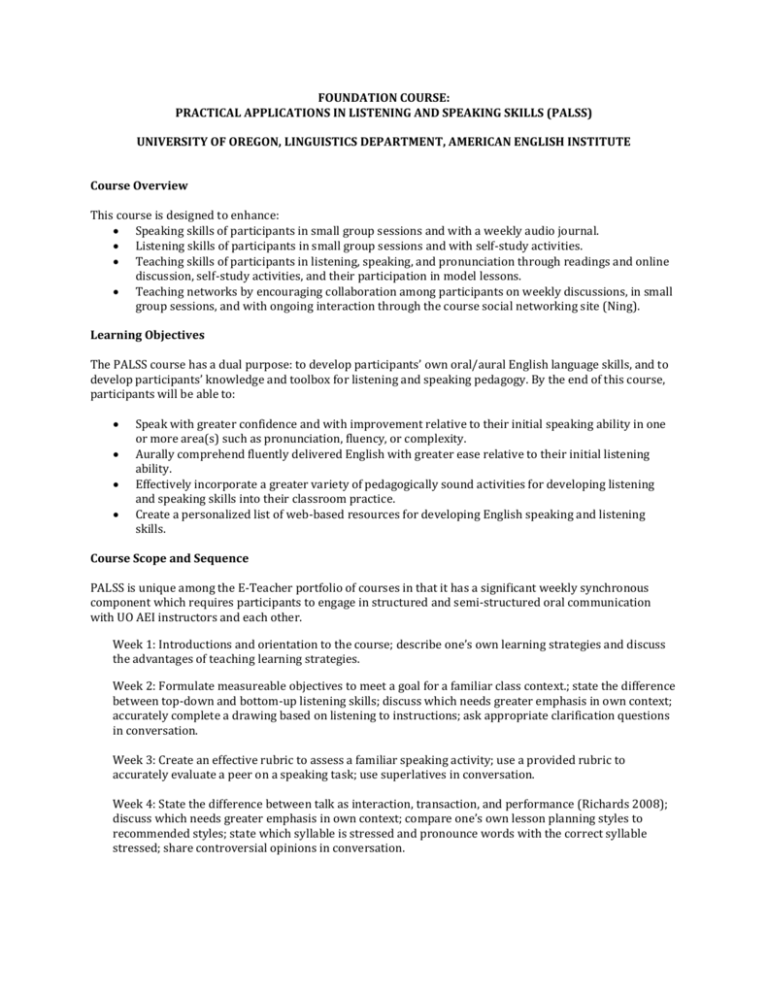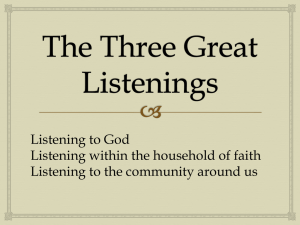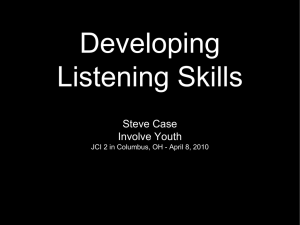PALSS description
advertisement

FOUNDATION COURSE: PRACTICAL APPLICATIONS IN LISTENING AND SPEAKING SKILLS (PALSS) UNIVERSITY OF OREGON, LINGUISTICS DEPARTMENT, AMERICAN ENGLISH INSTITUTE Course Overview This course is designed to enhance: Speaking skills of participants in small group sessions and with a weekly audio journal. Listening skills of participants in small group sessions and with self-study activities. Teaching skills of participants in listening, speaking, and pronunciation through readings and online discussion, self-study activities, and their participation in model lessons. Teaching networks by encouraging collaboration among participants on weekly discussions, in small group sessions, and with ongoing interaction through the course social networking site (Ning). Learning Objectives The PALSS course has a dual purpose: to develop participants’ own oral/aural English language skills, and to develop participants’ knowledge and toolbox for listening and speaking pedagogy. By the end of this course, participants will be able to: Speak with greater confidence and with improvement relative to their initial speaking ability in one or more area(s) such as pronunciation, fluency, or complexity. Aurally comprehend fluently delivered English with greater ease relative to their initial listening ability. Effectively incorporate a greater variety of pedagogically sound activities for developing listening and speaking skills into their classroom practice. Create a personalized list of web-based resources for developing English speaking and listening skills. Course Scope and Sequence PALSS is unique among the E-Teacher portfolio of courses in that it has a significant weekly synchronous component which requires participants to engage in structured and semi-structured oral communication with UO AEI instructors and each other. Week 1: Introductions and orientation to the course; describe one’s own learning strategies and discuss the advantages of teaching learning strategies. Week 2: Formulate measureable objectives to meet a goal for a familiar class context.; state the difference between top-down and bottom-up listening skills; discuss which needs greater emphasis in own context; accurately complete a drawing based on listening to instructions; ask appropriate clarification questions in conversation. Week 3: Create an effective rubric to assess a familiar speaking activity; use a provided rubric to accurately evaluate a peer on a speaking task; use superlatives in conversation. Week 4: State the difference between talk as interaction, transaction, and performance (Richards 2008); discuss which needs greater emphasis in own context; compare one’s own lesson planning styles to recommended styles; state which syllable is stressed and pronounce words with the correct syllable stressed; share controversial opinions in conversation. Week 5: Explain and give examples of 7 types of listening practice (Rost 2011); explain and apply knowledge of the use of dictations for listening diagnosis and intensive listening instruction; explain local issues in conversation. Week 6: Analyze discussion challenges and find solutions to discussion issues; participate in intensive listening activities and explain how to use them in own classrooms; discuss environmental issues in conversation. Week 7: Explain and apply knowledge of note-taking strategies; take accurate notes; explain how to incorporate extensive listening in classrooms; give and support opinions in conversations. Week 8: Analyze pronunciation activities practices in own classroom; explain how to integrate teaching pronunciation into other skill; practice listening for and using polite disagreement and agreement in conversation. Week 9: Analyze how songs can be incorporated into lessons to develop listening and vocabulary; practice rhythm and fluency with song activities; discuss and explain a favorite dish or recipe in conversation. Week 10: Evaluate course and give feedback; reflect on gains and skill development; share course experiences and reflect on course in conversation. Course Requirements for Certificate of Completion Course participants will be required to: Read the weekly readings and post at least two times each week on the related weekly online discussion. This is an asynchronous, text-based discussion. Participate actively & respectfully in the weekly synchronous meetings; arrive on time and be prepared to participate. Record a 2-5 minute reflection about the weekly activities in a weekly audio journal. Do self-study exercises (30 minutes) or activities each week, and note what was done in a self-study log. Participate in at least three webinars, either synchronously or asynchronously. Complete a variety of course tasks (for example, create a rubric; transcribe one minute of an audio journal and examine it for pronunciation errors). Created a detailed lesson plan as a final project, using new methods and activities that were learned during the course. E-Teacher participants must complete the final project and all other assignments with a score of 70% or higher to receive a passing grade for the course and a Certificate of Completion. The final project in this course is worth 30% of the total grade. Sample Materials and Resources Richards, J. C. (2008). Teaching listening and speaking: From theory to practice. (pp. 1-18). New York: Cambridge University Press. Rost, Michael. (2011). Chapter 9. Teaching and researching listening. Harlow, England: Longman. Vocaroo. (2013). Retrieved from http://www.vocaroo.com/






